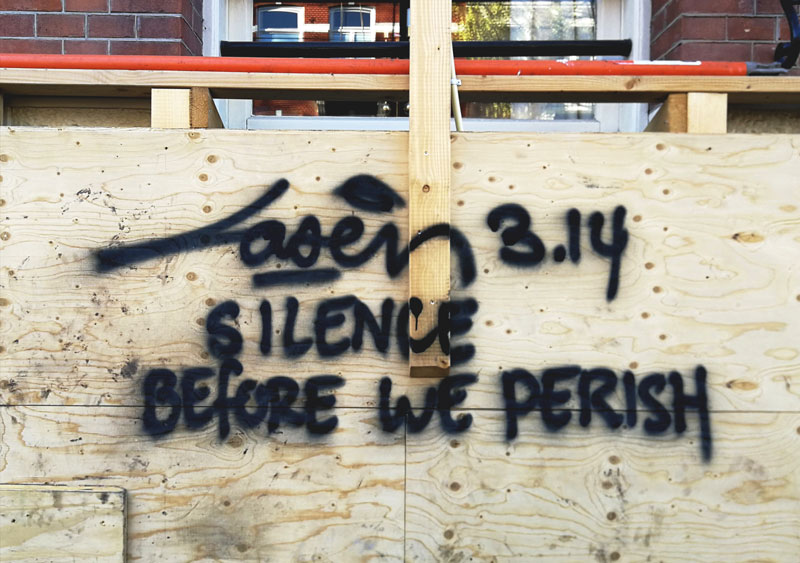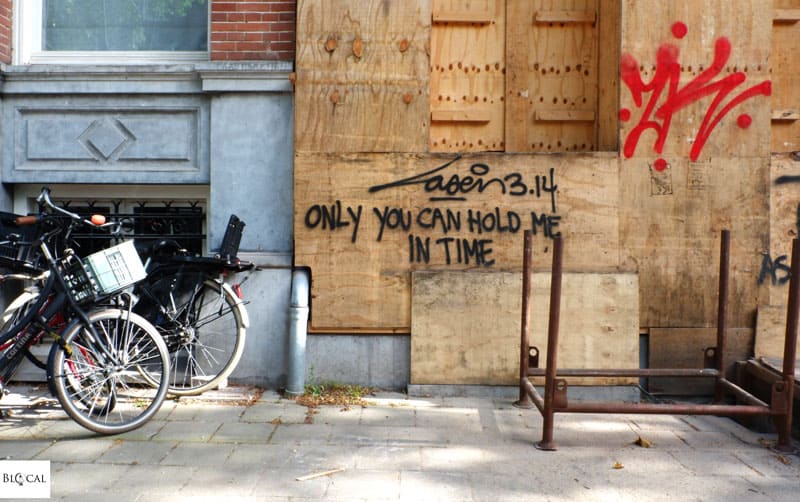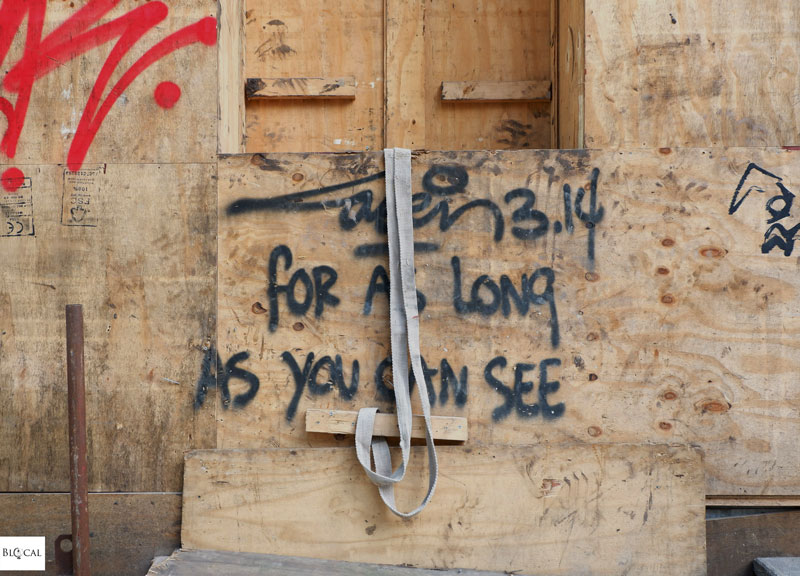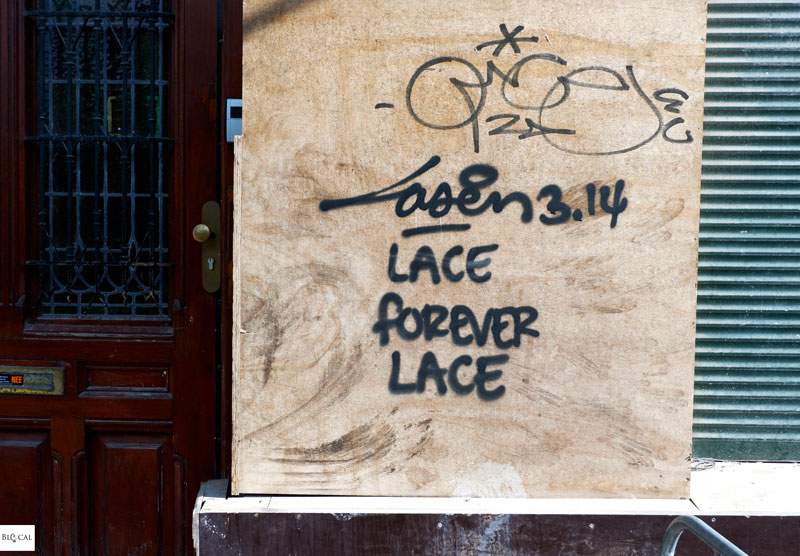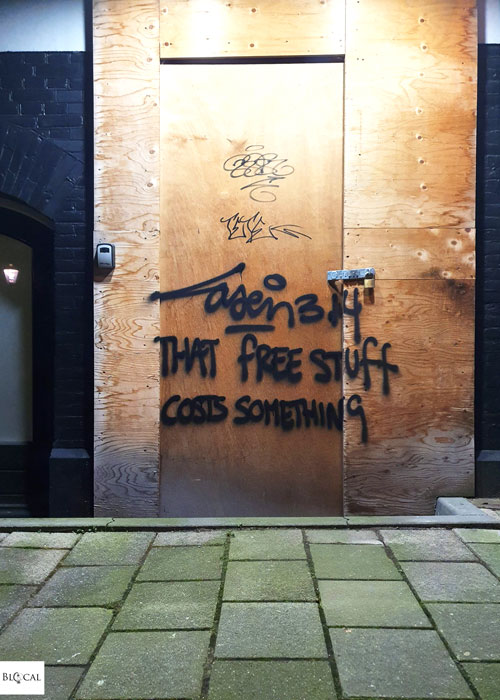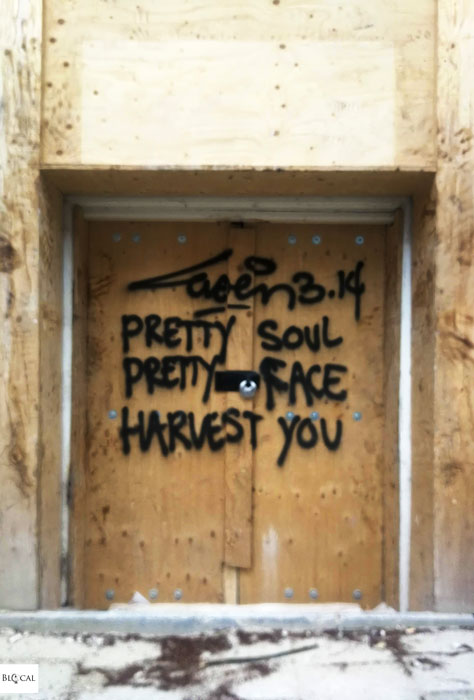Like his beloved sci-fi directors are fusing modern technology with human bodies, Laser 3.14 began combining graffiti with poetry in the early 2000s. Although he had been painting in the streets of Amsterdam for 20 years already, it was through his original and very recognizable ‘visual poetry‘ that he became popular in the street art scene of his city.
“I began painting in the streets in 1983 when I was around 11. Back then, street culture in Amsterdam was in its early days. The movement was influenced by rap, graffiti, and electric boogie, which later became breakdance. I saw a lot of tags while walking around Amsterdam, and, at some point, I began reading them, thus realizing that they were names -Ego, Dracula, Dragon, Harakiri, and Dr. Air. I spent a lot of time in the streets with my friends; it felt natural to write our names everywhere.”
Laser 3.14
Intrigued by the mysterious tags on the walls of Amsterdam, Laser 3.14 first pursued his life-long dream of becoming an artist through graffiti. He was hanging out with his friends, simply having fun with spray cans, and playing around with his name –which, back then, was ‘ARE.’ However, despite his young age and his playful attitude, he never considered graffiti anything less than an art form: a discipline he wanted to master.
Laser 3.14 was so committed to his dream that, a few years later, he enrolled in Graphic School. At the same school, several fellow graffiti writers, whose names he recognized from the streets, were studying visual subjects like drawing, printing, and typography.
After attending the Graphic School, he entirely devoted himself to the Art School of the street. He was hanging out with Nar, Hook, Hiz, Cyrus, Meno, Yep, Rico, Cyper, Croe, Sac, and Nog, restlessly drawing and sketching while dreaming of becoming as good as the best graffiti writers he saw on Amsterdam’s walls. Graffiti amplified his desire to become an artist, and he honed in on this new and exciting movement, which was –at the same time- groundbreaking yet something kids could do. He was already attracted by how ‘democratic’ graffiti could be.
By the end of the 1980s, when his passion for science fiction finally took over, he changed his name to Laser, eventually adding ‘3.14’ around 2000. The full name came to him while listening to a song called “Public Image” (by Public Image Ltd), which he realized could be abbreviated as Pi, whose numerical denomination is 3.14.
Under this space-powered tag, he began working on very detailed, sci-fi-inspired paintings. Through these paintings, inspired by David Cronenberg’s movies, he investigated the fusion between human bodies and technology and pursued his dream of becoming an artist. His dedication was so ardent that he barely noticed something else taking hold in his life during those early years: poetry. Inspired by the authors he loved to read at that time –Jack Kerouac, William Burroughs, and John Milton, among many others- Laser 3.14 began composing his own poems, although just as a side experiment -something he kept for himself for several years.
“I was listening to The Doors, Depeche Mode’s, and Lou Reed’s lyrics, and I wanted to write like that. Around 1999, I got bored with my graphic art: at some point, the thing I liked the most about my paintings was the sentence I always wrote underneath them, so I skipped the graphic part and stuck to those short, poetry-filled statements.”
Laser 3.14
Alongside sci-fi, another topic fuelling Laser 3.14’s poems was –and still is- politics.
“Even when just drinking at a café, my friends and I have always discussed what was happening around us, either in the world or in our city, such as that ‘tsunami’ of regulations that –back in the 1990s- turned Amsterdam from a very liberal, open city to a more rule-based, restricted society. I’ve always been engaged in politics, although I don’t see myself as an activist, nor am I an ideologue. Often activism results in restricted visions based on opinions and political bias, while I like to keep my mind open. I see myself as an artist who talks about what he sees.”
Laser 3.14
Indeed, if you put Laser 3.14’s works on a timeline, you will recognize some significant events that happened either worldwide or in Amsterdam. Also, you will be able to guess something about his personal life (although he would insist that what he writes is always personal, regardless of whether it seems political or not).
“Sometimes I’m totally in love, so you’ll see all those love poems appearing around the city.”
Laser 3.14
Although innermost, these sparkles that creep into his artworks and eventually end up on Amsterdam’s walls are the only insights you will ever have into his private life, which he firmly keeps away from the spotlight.
“People assume I want to be anonymous because of the legal implications of painting independently in the streets, but the truth is that I value my privacy. Moreover, when I was a kid and saw all those tags, I didn’t know what those graffiti writers looked like: that mystery ignited my imagination. In the same way, I believe my work will benefit from my anonymity because people will focus on it, not my appearance.”
Laser 3.14
Laser 3.14’s strong visual identity is yet another way to keep the spotlight on his work: his poems are always mono-chromatic (he mainly uses black paint), written in very clear calligraphy, and composed in English.
“I want to write for everybody, nobody excluded. I grew up listening to a lot of rap music, which is very word-based, and the lyrics are in English. Moreover, it didn’t feel right when I tried to write in Dutch. So English felt more natural to me and –simultaneously- it is more inclusive.”
Laser 3.14
Unlike graffiti, whose undecipherable calligraphy is aimed at a restricted and exclusive group of insiders, Laser 3.14’s street poems are democratic. His Copernicus revolution consisted in writing for the passers-by and not only for other graffiti artists, opening a dialogue that everybody is welcome to join.
Moreover, Laser 3.14 only writes on wooden panels or similar temporary structures, whose surface is often smoother and cleaner than concrete walls, thus making the artwork neater and easier to read –and less likely to be perceived as ‘vandalism’ by his fellow citizens.
“In the beginning, I also painted on walls, but now I like the idea that things are temporary. All these wooden panels around the city are like a universe map: while a supernova explodes, another star is born, and all planets carry on at different life stages. At first, I was frustrated by how quickly my work would disappear, but now I like the image of this blinking constellation.”
Laser 3.14
Tangible evidence of the ‘tsunami’ that changed Amsterdam, construction site panels are mushrooming around the town. By painting them, Laser 3.14 takes his city back, one wooden board at a time.
“Amsterdam isn’t the city it used to be; it killed its counterculture. Take graffiti, for example: they tried to control it, but graffiti in a controlled environment isn’t graffiti anymore. Don’t get me wrong; I like my city: walking around it is always a great inspiration, although a bit less nowadays because the streets are so clean and everybody looks the same. I hope that soon something happens, something that will trigger new ideas and underground movements with unofficial poetry, music, or movies. I feel that now we are back to the 1950s’ conservatism, where everything is clean, and everybody is nice under the guise of forced politeness -but also a bit scared of expressing his ideas. I find this political correctness mind-numbing.”
Laser 3.14
Today, streets are not just cleaner; countless billboards and commercial advertising also take them over. In a world where the loudest voices are those who paid to be heard, Laser 3.14 is still highly committed to opening a dialogue -free and accessible to everybody- through his statements sprayed in the streets.
His dedication is so sincere that he is still going out at night every week to put up his work, despite the recognition already gained in the latest 20 years, an indicator of which could be all the gallery shows, museum exhibitions, and books (“Are you reading me?” published in 2009 and “White Phosphorous: Poems” published in 2013). His drive to make art is still paramount.
However, although appreciated by an extensive public, at first, his ‘visual poetry’ struggled to get recognition within the graffiti world: graffiti writers perceived it as too different from what they do.
“People can get easily nervous –even disturbed- if you are not following the rules. I find it sad that there are so many rules in graffiti because graffiti started as something rebellious whose goal was to break with the rules, while today graffiti is conservative.”
Laser 3.14
Laser 3.14 went against all the rules -in terms of style, content, and even ‘street attitude’- and he occasionally overflew into different art forms, for example, by undertaking a sound design poetry project or merging his poems with sculpture (he produced both neon pieces and steel shields for gallery shows).
The resulting hybrid stars are still part of his ever-changing constellation, which pulsates along the flow of his verses. The only thing he held on to was –and still is- his profound sensitivity and the vibrant poetry evoked by everyday living.
“Two or three years ago, I was walking along the canals when I saw one of those Venetian masks floating in the water amid all these leaves. Those are the moments when poetry happens. Everything is poetic in Amsterdam if you listen to it.”
Laser 3.14
Read also > As Seen on The Street of Amsterdam: A Street Art Guide
